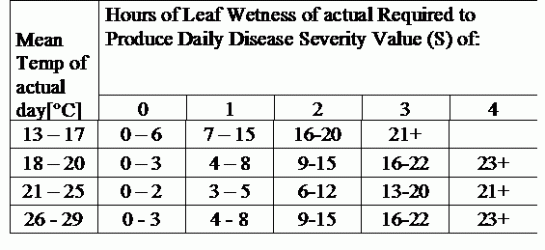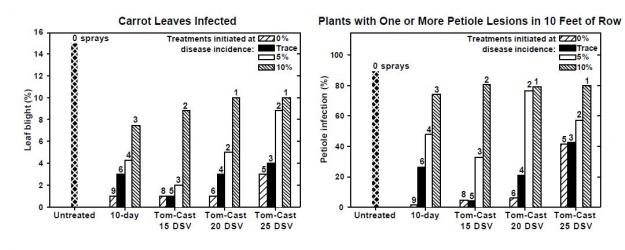
Carrot disease models
Alternaria model for carrots
Carrot (Daucus carota) — Alternaria dauci causes Leaf Blight.
Host: Carrot, Parsley
The disease is caused by the pathogen Alternaria dauci. The pathogen overwinters in crop refuse or on alternate hosts. The disease also may be seed borne. Older leaves are more susceptible to Alternaria spp. than younger leaves. Leaf spots are common in carrots grown for seed production.
Symptoms
Alternaria leaf blight usually appears first in early fall on older leaves (sometimes called late blight). When large amounts of infested refuse are present, spring infection can occur. Seedlings can develop a damping-off symptom from early infections. Lesions generally appear along leaf margins and are dark brown to black with a yellow border. Spots may coalescence, girdling the petiole and killing the leaf. The spots of this disease are easily confused with Cercospora leaf blight, but Alternaria generally is more irregularly shaped and darker in color.
Model TOMCAST
Background: TOMCAST (TOMato disease foreCASTing) is a computer model based on field data that attempts to predict fungal disease development, namely Early Blight, Septoria Leaf Spot and Anthracnose on tomatoes. Field-placed data loggers are recording hourly leaf wetness and temperature data. These data were analysed over a 24-hour period and may result in the formation of a Disease Severity Value (DSV); essentially an increment of disease development. As DSV accumulate, disease pressure continues to build on the crop. When the number of accumulated DSV exceed the spray interval, a fungicide application is recommended to relieve the disease pressure.
TOMCAST is derived from the original F.A.S.T. (Forecasting Alternaria solani on Tomatoes) model developed by Drs. Madden, Pennypacker, and MacNab? at Pennsylvania State University (PSU). The PSU F.A.S.T. model was further modified by Dr. Pitblado at the Ridgetown College in Ontario into what we now recognize as the TOMCAST model used by Ohio State University Extension.
What is DSV?
A Disease Severity Value (DSV) is the unit of measure given to a specific increment of disease (early blight) development. In other words, a DSV is a numerical representation of how fast or slow disease (early blight) is accumulating in a tomato field. The DSV is determined by two factors; leaf wetness and temperature during the “leaf wet” hours. As the number of leaf wet hours and temperature increases, DSV accumulate at a faster rate. See the Disease Severity Value Chart below.

Conversely, when there are fewer leaf wet hours and the temperature is lower, DSV accumulates slowly if at all. When the total number of accumulated DSV exceeds a preset limit, called the spray interval or threshold, a fungicide spray is recommended to protect the foliage and fruit from disease development.
The spray interval (which determines when you should spray) can range between 15-20 DSV. The exact DSV a grower should use is usually supplied by the processor and depends on the fruit quality.
Following a 15 DSV spray interval is a conservative use of the TOMCAST system, meaning you will spray more often than a grower who uses a 19 DSV spray interval with the TOMCAST system. The trade-off is in the number of sprays applied during the season and the potential for the difference in fruit quality.
Studies have been initiated at Michigan Staate University to test the disease forecasting system, TomCast, for use in managing foliar blights on carrots. TomCast has been used commercially in tomato production and has recently been adapted for use in the disease management of asparagus. Processing carrots ‘Early Gold’ were planted with a precision vacuum seeder at the MSU Muck Soils Research Farm in three rows 18 inches apart on a raised bed that was 50 feet long. Carrot beds were spaced on 64-inch centers and in-row seed spacing was 1 inch.
Each of the four replications of the experiment was located in separate blocks of carrots that consisted of 36 beds. Seventeen treatment beds 20 feet long were randomly placed in a checkerboard pattern in each replication. Treatments were applied with a CO2 backpack sprayer that was calibrated to deliver 50 gallons per acre of spray solution using 8002 flat fan nozzles.
Treatments consisted of untreated and different schedule applications of Bravo Ultrex 82.5WDG (22.4 oz/A) alternated with Quadris 2.08SC (6.2 fl oz/A). The chemical program was applied on a 10-day calendar program as well as when predicted by the TomCast disease forecaster. Three different prediction thresholds of 15, 20, and 25 DSVs were used to time fungicide applications. When the cumulative daily DSV values reached the determined threshold a spray would be applied.
Each treatment regime was initiated at four different levels of disease pressure (0%, trace, 5%, and 10% foliar blight). The first treatments were applied on 2 July and the last application of any treatment was made on 21 September. Ten feet of each centre row of the spray blocks were marked before the first application and were used for weekly disease ratings (see graphs, below). Yields were taken from the same ten feet section of row by hand harvesting the carrots and topping and weighing.

This indicates that the first treatment in carrots should be done as soon as we can find the first disease incidence in the field. From now on it worked fine by the use of the TomCast model with a threshold of 20 DSV accumulated since the last spray.
FieldClimate determines the severity of an Alternaria Infection in two different models:
1. TomCast Alternaria Model: independence of the climatic conditions of hours of leaf wetness and air temperature, values of the severity of an Infection (from 0 – 4, see the table here) are determined.
2. Infection of Alternaria daucii & alternata: In this model, a rain event does not have to take place to calculate Alternaria Infections. The involved climatic conditions are the duration of leaf wetness, air temperature and relative humidity. Under favourable conditions, the Infection will be 100%, which means that Alternaria spores had already favourable conditions to infest new plant tissue (see the table here).
Source: Jim Jasinski, TOMCAST Coordinator FOR OHIO, INDIANA, & MICHIGAN
Cercospora Leaf spot
This disease is caused by the plant pathogenic fungus Cercospora beticola. It occurs wherever table beets, Swiss Chard, sugar beet, and spinach are grown and is one of the most important diseases affecting the Chenopodium group. It can result in significant losses, particularly in late summer when conditions are favourable (high temperatures, high humidity, long leaf wetness periods at night). Leafy greens become unmarketable, and beetroots fail to grow to full size when the disease is severe.
Symptoms
Symptoms occur as numerous, initially small circular leaf spots. Spots have a pale brown to off-white centre with a red margin. Lesions expand in size, coalesce, turn grey as the fungus sporulates, and can result in extensive loss of foliage. Leaves at the centre of the plant are often less severely affected. The pathogen produces sclerotia or stromata which can be seen with a hand lens as small, black dots in the centre of lesions. Lesions may also occur on petioles, flower bracts, seed pods, and seeds. Leaf symptoms are similar to those caused by Beet Phoma (Phoma betae), except that the phoma will have more obvious tiny fruiting bodies in the lesions and can also affect the roots. The pathogen C. beticola survives between crop cycles in residues from infected crops (as sclerotia), in weed hosts, and on the seed. It can survive in the soil for up to two years. High levels of disease can result from just a few infected plants since each lesion produces numerous conidia. Several cycles of infection and conidium production may occur with favourable environmental conditions. Spores can penetrate the leaf directly through open stomates. The pathogen is favoured by high relative humidity and temperatures between 24-30˚C and is spread by rain splash, wind, irrigation water, insects, workers, and equipment. Leaf wetness during the night, even with dry conditions during the day, encourages disease. Successive plantings made close together can allow the disease to move from one planting to the next.
Model for prediction of Cercospora Leaf Spots
Because of the strict environmental conditions needed for an infection the disease is predictable within a time period, when outbreaks are mostly favourable. The prediction system is an estimate of the potential for disease development based on the relative humidity and temperature measured within fields. This system was developed in the late 1980s by UNL scientists, Albert Weiss and Eric Kerr, and still is being used today at the University of Nebraska Panhandle Research and Extension Center. Over the last 15 years, the forecasting system has utilized up to 14 sites per season located in Nebraska, Colorado, Wyoming, and Montana. Results are then collated and disseminated to more than 40 sources, including consultants, researchers and media (Web, print, television, and radio). This system assumes that a susceptible host and sufficient inoculum are present. Based on hours of leaf wetness or high relative humidity (> 90 percent) and temperature during this period, a daily infection value (DIV) is determined (Table I).
If the two-day sum of the DIVs is seven or greater, there is a strong potential for infection and further disease development. If the sum is less than six, there is little likelihood of infection. The following example will illustrate how to use the information in Table I. Assume that on Day 1 there were 13 hours of leaf wetness and the mean temperature during this period was 63 o F. On Day 2, there were 15 hours of leaf wetness with a mean temperature of 65 o F. The DIV for Day 1 was three while on Day 2 it was four. The sum of these two days was seven, resulting in conditions that would favour infection. If no symptoms were observed on leaves, then the DIV sum indicates that careful scouting is advised, and if symptoms were present, then a fungicide application would be warranted. If on Day 3, there were 12 hours of leaf wetness and the temperature during this period was 62 o F, then the DIV sum for Days 2 and 3 is 4+0=4, and no action would be necessary. See the graph here.
Recommended equipment
Check which sensor set is needed for monitoring this crop’s potential diseases.
